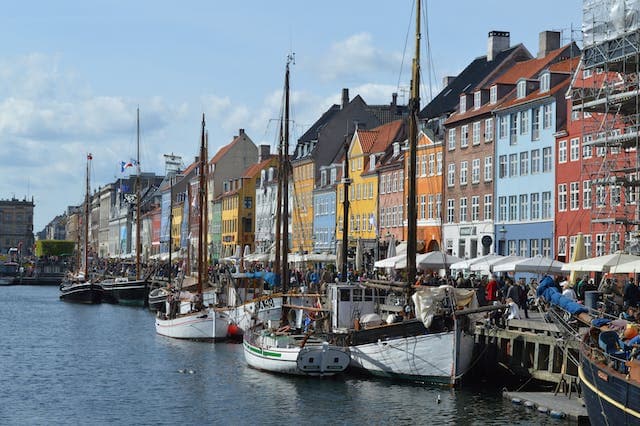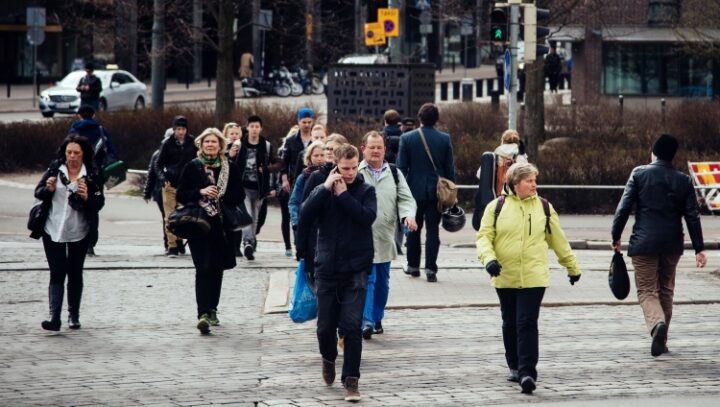
Migration and population
The Baltic Sea unites the Nordic countries and the Baltic States (referred to as the NB8) as a single geographical region. But through joint efforts, the region should become an even more attractive place in a globalising world for companies, financiers and researchers – and a better place to live for everyone. It should also be a place where the impact of human activity on the environment is taken into consideration.
The governments of the Nordic countries have been harmonising their policies and actions through the Nordic Council of Ministers since 1971, while cooperation with the Baltic States has been pursued through its Tallinn, Rīga and Vilnius offices since 1991.
The Nordic countries, the Baltic States and the other countries on the Baltic Sea support the European Union’s Baltic Sea Strategy and the key areas it focuses on:
- protection of the environment;
- boosting welfare and prosperity – removing market obstacles; the ‘fifth freedom’ i.e. free movement of knowledge; and reinforcing knowledge and competitive ability through the Top-Level Research Initiative;
- boosting access and attractiveness – developing an open, transparent and effective electricity market; energy efficiency; and renewable energy; and
- security – ensuring a more rapid response to health threats; and combating human trafficking and major cross-border crime.
In order for a more unified region to rise up around the Baltic Sea, we work closely with experts from Estonian departments and others in their fields, get them together with their colleagues from the Nordic countries and help to produce synergy.
Find out more about the Nordic countries’ cooperation on freedom of movement.
More about migration and population
Held events
Nordic-Baltic project 2021-2023 FOR-IN aims at fostering refugee and immigrant integration at the local level by creating country-specific intersectional cooperation models and regional networks of practitioners in the Nordic-Baltic Region.
Nordic Council of Ministers’ Offices in Estonia in collaboration with the Estonian Ministry of Education and Research, the University of Tartu, Tartu Welcome Centre, the UNHCR Representation for the Nordic and Baltic Countries and the Swedish Embassy in Tallinn arranged an international conference “Integration through education and engagement of local actors” 24th of October 2023 at the KUMU Art Museum of Estonia in Tallinn.
The Nordic-Baltic Migration Conference “Cross-border Mobility in the Nordic-Baltic Region” took place on September 18th 2020 at 10.00-13.00
Nordic Council of Ministers’ publications on:
Presentations from events
- Tiit Tammaru, Professor of Urban and Population Geography at the University of Tartu, Member of the Estonian Academy of Sciences: Where do refugees live and work in Sweden, how has it changed in time (trajectories of spatial assimilation)
- Christopher Jamil de Montgomery, Assistant Professor, Department of Public Health, University of Copenhagen. Danish Research Centre for Migration, Ethnicity and Health. NordForsk Project: Coming of Age in Exile (CAGE): How do we ensure the best possible health and welfare for Ukrainian refugee children and young people seeking a safe place in the Nordic countries?
I PANEL
- Mads Ted Drud-Jensen, Senior Adviser of the Integration department at the Danish Refugee Council of Integration
- Ausra Raulusonytė, Arts Agency “Artscape”
- Jonna Mannberg, Head of the board, Refugees Welcome Stockholm
- Anna Buzaeva, Expert, reception of asylum seekers, Finnish Red Cross
- Ieva Raubiško, Senior Researcher, centre for public policy Providus
II PANEL
- Janika Hango, CEO of Tartu Welcome Centre
- Valentina Demidenko, Director of Center for Social Services in Jonava District, Lecturer at Kaunas University of Applied Sciences; Psychologist of the Red Cross
- Ilze Meilande, Head of Society Integration and Participation Division; Neighbourhood Development, Society Integration and Customer Service Department; Riga City Neighbourhood Residence Centre
- Lisbeth Iversen, Leader of the network „With a Heart For Arendal“, Arendal, Oslo School of Architecture and design
- Nichole Leigh Mosty, Director of the Multicultural Information Centre
- Jussi Jauhiainen, Professor of University of Turku, Cross-Border Cooperation Between Estonia and Finland
- Jonas Wendel, Chief of Staff at Nordic Council of Ministers´, Secretary General’s Office, Cross-border Mobility: A Regional Matter of National Importance
- Zaiga Krisjane, Professor of the University of Latvia, Department of Human Geography, Overview of the Mobility Trends: Experience From Latvia
- Donatas Burneika, Professor of the Vilnius University, Head of the Institute of Human Geography and Demography, Trends of Migrations in Lithuania 2000 – 2019
- Tiit Tammaru, Professor of Urban and Population Geography at the University of Tartu, Academician, Changing Mobility Between Estonia and Finland
- The Ministry of the Interior and the European Migration Network Estonian Contact Point, Overview of Migration Statistics 2015-2019
- Aune Valk, Vice Rector for Academic Affairs, University of Tartu: Higher Education in English at National University: for Whom and for What?
- Tuomas Martikainen, Director of the Migration Institute of Finland: Future Global Migration Trends
- Irma Garam, Senior Adviser, Finnish National Agency for Education. Information and Analysis: Trends in International Student Migration and Integration in Finland
- Norma Rose, consultant, European Migration Network Service Provider (ICF): Challenges and Best Practices in Retention from the EMN 2018 Study on Attracting and Retaining Third Country National Students
- Theda Minthe, Head of Science City Hannover, City of Hannover, Lord Mayors’s Office, Germany: How to establish long-term cooperation of science, economy and politics: Welcome Service for international students and Hannover Skilled Workers’ Alliance
- Piret Hartman, Estonian Ministry of Culture, Undersecretary for Cultural Diversity: The Role of Education in Integration Processes
- Margus Pedaste, Professor of the University of Tartu, Head of the Pedagogicum and Centre for Educational Technology & Laura Kirss, University of Tartu, Centre for Teacher Education and Higher Education, RITA project: Integrated Estonian School and Related Expectations for Teacher Education
- Kenneth Broman’s opening remarks
- Replay of Migration conference 2018 live stream
- Raul Eamets, Dean of Faculty of Social Sciences, University of Tartu: Smart Migration Policy
- Olof Åslund, Director-General, Institute for Evaluation of Labour Market and Education Policy (IFAU): Labour Market Entry of Non-Labour Migrants
- Ruth Annus, Head of Citizenship and Migration Policy Department, Ministry of the Interior of Estonia: Developments in Estonian Migration Policy
- Matti Sarvimäki, Associate Research Professor, VATT Institute for Economic Research in Finland: Integration of Immigrants into the Finnish Labor Markets
- Martin Ehala, Professor, University of Tartu: Managing Cultural Diversity in the Migratory Era
- Silver Stõun, Migration Expert, European Migration Network: Illegal Employment of Third-Country Nationals in the European Union and the Nordic-Baltic Region
- Hjördís Rut Sigurjónsdóttir, Research Fellow, Nordregio: Policies and Measures for Speeding up Labour Market Integration of Refugees in the Nordic Region
- Piret Hartman, Undersecretary of Cultural Diversity, Ministry of Culture: Challenges Facing the Estonian Integration Policy
- Henrik Emilsson, Researcher, Malmö University, Institute for Studies of Migration, Diversity and Welfare (MIM): How to Measure the Effectiveness of Integration, Indicators of Integration
- Summary of the Nordic-Baltic migration conference 2017
- Watch full conference video online at Postimees opinion portal
- Marju Lauristin, Member of the European Parliament, Professor of University of Tartu: How to conceptualize nation states at the age of migration: migration and integration of new arrivals
- Anders Danielsson, General Secretary of the Red Cross in Sweden: Lessons learned – how Swedish society managed to help 136 000 refugees in six months
- Klára Fóti, European Foundation for the Improvement of Living and Working Conditions, Research Manager, Social Policies: Labour market integration of refugees and asylum seekers: different approaches in Europe after crisis
- Eero Janson, Chairman of the Board of the Estonian Refugee Council: Estonia and the quota system: one year later
- Catrine Bangum, Senior Adviser, Nordic Council of Ministers: The Initiatives of the Nordic Council of Ministers in answering the challenges of immigration and integration of newly arrived immigrants
- Tuomas Martikainen, Director of the Migration Institute of Finland: What happened to the asylum seekers in 2015 in Finland?
- Maarja Saar, Postgraduate Researcher in Sociology at Södertörn University, TRANSWEL research project: Mobility and welfare management between Estonia and Sweden
- Triin Vihalemm, Professor of the University of Tartu: Media and mobility in Estonian society
- Marta Bivand Erdal, Senior Researcher of the Peace Research Institute, Oslo (PRIO): Recent migration to Norway: integration, diversity and implications for nation and state
- Tiit Tammaru, Raul Eamets, Professors of the University of Tartu: Estonia in the era of migration
- Video: All presentations on 31 March
- Video: All presentations on 1 April
- Dr. Tuomas Martikainen, Director of the Institute of Migration in Turku, Finland: The Experiences of Recent Immigration Flows: Comparison of the Nordic Countries
- Liana Roosmaa, Adviser of the Ministry of the Interior, Estonia: The Integration of Newly Arrived Migrants, Example of Estonia
- Tiit Tammaru, Professor of Urban and Population Geography of the University of Tartu, Estonia: The Integration of Newly Arrived Immigrants Across Multiple Life Domains: Evidence from Sweden
- Mari Vaattovaara, Professor in Urban Geography and Vice Dean Faculty of Science of the University of Helsinki, Finland: Socio-Economic Segregation in Nordic Cities
- Leen Rahnu, Researcher of the Tallinn University, Estonian Institute for Population Studies: Formation of Ethnically Mixed Partnerships: Estonia in Single-country and Comparative Perspective
- Eskil Wadensjö, Professor of the Swedish Institute for Social Research, Stockholm University: Integration of Unaccompanied Refugee Children in the Swedish Labour Market
- Sheila Maas, European Migration Network/ ICF International: Integration of Beneficiaries of International Protection to the Labour Market – Policies and Good Practices from the Nordic-Baltic Region
- Pieter Bevelander, Professor of the Malmö Institute for Studies of Migration, Diversity and Welfare, Sweden: Refugee Labour Market Integration, Comparing Two Cool Countries, Canada and Sweden
- Eva-Maria Asari, Migration Expert of the Estonian Academy of Security Sciences: The Role of State and Local Governments in Receiving the Beneficiaries of International Protection
- Maria Golubeva, Head of Migration Policy Programme of the Centre for Public Policy PROVIDUS, Latvia: Policy Challenges for the Integration of Migrants in Latvia: Labour Market, Education, Participation
- Katja Vänskä-Rajala, Project Manager of the Ministry of Employment and the Economy, Finland: Policies and Practices of Resettlement of Refugees in Finland
- Christoffer Melson, Chairman of Committee of Labour Market of the Vejle Municipality, Denmark: Experience of the “Work-First” Approach to Refugee Integration in Vejle Kommune
- Triin Raag, Head on International Protection Policy of the Ministry of Social Affairs, Estonia: The Readiness of the State and Local Governments in Receiving Applicants and Beneficiaries of International Protection
- Vladimir Šokman, Chairman of the City Council of Tartu, Estonia: The First Experiences of the Estonian Local Governments in Receiving the Beneficiaries of International Protection
- Eero Janson, Director of the NGO Estonian Refugee Council: Civil Society Role and Experiences in the Reception of Refugees
- Tiit Tammaru, Professor of Urban and Population Geography of the University of Tartu, Estonia: Conclusions of the Second Day of the Conference
- Christer Haglund, Director of the Nordic Council of Ministers’ Office in Estonia: Opening speech
- Marju Lauristin, MEP, Professor of Tartu University: Diversity of Our Societies and the Intra-EU Labour Migration
- Rasmus Ole Rasmussen, Senior Research Fellow, Nordregio: Comparative Analysis of Immigration in the Nordic and Baltic Countries
- Mihails Hazans, Professor, Faculty of Economics and Management, University of Latvia: Return Migration Intentions to Latvia, Based on Recent Survey of Emigrants
- Annika Forsander, Head of the Centre of Expertise, Ministry of Empoyment and the Economy, Finland: The Nordic Welfare State and Immigration, Experiences of Finland
- Pieter Bevelander, Professor, Malmö Institute for Studies of Migration, Diversity and Welfare (MIM), Malmö University, Sweden: The World’s Most Open Country: Labour Migration to Sweden after the 2008 Law
- Niels Jul Nielsen, Associate Professor, European Ethnology, Saxo Institute, University of Copenhagen, Denmark: Two cases of labour migrants in Denmark on ‘orderly’ conditions – a success story?
- Berth Sundström, Director of the Nordic Council of Ministers’ Office in Estonia: Opening speech
- Taavi Rõivas, Minister of Social Affairs of Estonia: Opening speech
- László Andor, Commissioner for Employment, Social Affairs and Inclusion, European Commission: Labour Mobility: A European Perspective
- Ken-Marti Vaher, Minister of the Interior of Estonia: Estonian Migration Policy
- Eskil Wadensjö, Professor of Labour Economics, the Swedish Institute for Social Research (SOFI), Stockholm University: Central and Eastern European migrants and the Swedish Labour Market
- Häli Tarum, Labour Market Analyst, Ministry of Social Affairs of Estonia: Migration Potential of Working-age Population in Estonia in 2013 (in Estonian)
- Dr Frida Thorarins, Chair of the MIRRA/CIRRA /Center for Immigration Research Reykjavik Academy, Iceland: Labour Migrants from Central and Eastern Europe in the Nordic Countries – Patterns of Migration, Working Conditions and Recruitment Practices
- Mihails Hazans, Professor, University of Latvia: Emigration Intentions and Fertility Potential in Latvia
- Tiit Tammaru, Professor, University of Tartu, Estonia: Transnationalism in the Nordic-Baltic Region
- Trine Lund Thomsen, Associate Professor, Aalborg University, Denmark: Skilled Immigrant Labour Market Integration in Denmark
- Laura Kirss, Head of Education Policy Programme, Praxis Center for Policy Studies, Estonia: Talent Policy in Estonia: From Pieces to the Bigger Picture
- Kristjan Kaldur, Analyst, Institute of Baltic Studies, Estonia: Experiences of Integration of Skilled Professionals from Other Countries (in Estonian)
- Ott Toomet, Research Fellow, University of Tartu, Estonia: Leaving Your ‘Fatherland’? Ethnic Differences in Migration Intentions
- Eva-Maria Asari, Project Manager, Centre for Migration Studies, Estonian Academy of Security Sciences: EU Blue Card in the Nordic-Baltic Region
- Enel Pungas, Head of Department, Population Department, Estonian Ministry of the Interior: Factors Influencing Intentions to Study Abroad (in Estonian)
- H.E Anders Ljunggren, Ambassador of Sweden in Estonia: welcome address
- Professor Raul Eamets, University of Tartu: Smart Migration Policy
- Siim Raie, Director of the Office of the President of the Republic of Estonia: Experiences from the Project Bring Talent Home (Talendid Koju)
- Marianne Hansen, Director, WorkinDenmark: Danish Experience on Attracting Highly Qualified Labour Force
- Heikki Mäki, Consultant, Human Resource Services, Finesta Baltic OÜ: Employers View on Proactive State Policy of Immigration
- Eva-Maria Asari, Project Manager, Estonian Academy of Security Sciences: Attracting Highly Qualified Third-Country Nationals in the European Union and Estonia
- Kristina Narusk, CEO, Estonian Service Industry Association: Can Estonia become a target country for talented people and profitable jobs?
- Berth Sundström, Director of the Nordic Council of Ministers’ Office in Estonia: Opening statements at the The ‘Migration and Demographic Challenges in the Nordic-Baltic Region’ conference (7 & 8 March 2013, Tallinn, Estonia)
- H.E. Mr Jan Palmstierna, Ambassador of Sweden to Estonia: Opening statements at the The ‘Migration and Demographic Challenges in the Nordic-Baltic Region’ conference (7 & 8 March 2013, Tallinn, Estonia)
- Taavi Rõivas, Minister of Social Affairs of Estonia: Opening statements at the The ‘Migration and Demographic Challenges in the Nordic-Baltic Region’ conference (7 & 8 March 2013, Tallinn, Estonia)
- Lauri Bambus (Ministry of Foreign Affairs of Estonia): Opportunities and Responsibilities in Baltic Sea Region
- Ulf Holm (Swedish Parliament, Riksdag): Migration as a Motor for Exports in Sweden
- PhD Elli Heikkilä (Institute of Migration, Turku, Finland): Immigrants on the Finnish Labour Market
- PhD Jon Horgen Friberg (Fafo Institute for Labour and Social Research, Norway): Labour Migration to Norway from Poland and the Baltic Region – Trends and Challenges
- Andrius Tekorius (Ministry of Social Security and Labour of Lithuania): The Experience of Lithuania in Labour Migration between the Nordic Countries and Baltic States
- Liis Reiter (Ministry of Social Affairs of Estonia): Labour Migration from Estonia in Recent Years
- PhD Raul Eamets (University of Tartu, Estonia): The Economic Impact of Migration on the Destination and Sending Country
- PhD Per Lundborg (Swedish Institute for Social Research (SOFI), Stockholm University): Swedish Experiences of Labour Migration between the Nordic and Baltic Countries
- MSc Johanna Roto (NordRegio): The Impact of Migration on Nordic Cities and Regions
- PhD Tiit Tammaru (Tartu University, Estonia): Waves of Outwards Migration in Estonia
- Ivi Normet (Ministry of Social Affairs of Estonia): The Impact of Labour Migration in the Field of Medical Care in Estonia
- Marianne Hansen (Workindenmark, Danish Ministry of Labour): How to Meet the Challenges of Labour Migration – Experiences from Denmark
- Helina Maasing (Centre for Migration Studies, Estonian Academy of Security Sciences): Labour Migration to Estonia from Third Countries
- PhD Dovilė Krupickaitė (Vilnius University, Lithuania): Destination Change of Emigration from Lithuania
- PhD Elina Apsite-Berina (University of Latvia): Shift in Occupational Mobility Pre- and Post-Migration: A Comparative Analysis of Latvian Migrants in the Nordic Countries
- PhD Rein Ahas (University of Tartu, Estonia): Using Mobile Positioning Techniques to Analyse International Commuting
- Conference: The EU Strategy for the Baltic Sea Region and topical legal and economic issues, including insolvency (8.-9.11.2012)
- The Nordic Council of Ministers and the EU Baltic Sea Action Plan
- Guidelines 2009–2013 for the Nordic Council of Ministers’ co-operation with Estonia, Latvia and Lithuania
- NB8 wise men report (Valdis Birkavs, Søren Gade 2010)
- Magdalena Ochej-Lokuciejewska: Internal Market in the Baltic Sea Strategy – Polish/Swedish flagship project
- Kristin Eckardt Johannsen: Removing hindrance to the internal market in the Baltic Sea Region
- Tom Corrie: Identifying obstacles in the Single Market. The role of assistance services
- Martin Hirvoja: The new draft Estonian public commercial code and the services directive – an attempt to create clear, unified and hassle free legal environment for entrepreneurs offering goods or services
- Merike Kompus: Cooperation in clusters and implementing the services directive
- Andres Ruubas: Point of Single Contact. Estonian experience (PSC)
- Johan Englund: Standardization and Certification – Important tools in ensuring the free movement of services
- Anneli Andresson-Bourgey: Services Directive: consolidation of achievements – and future actions
- Fredrik Melander: Nordic collaboration on eScience and eInfrastructure
- Olli-Pekka Rissanen: PEPPOL. Pan European Public Procurement Online
- Arvid Welin: STORK – eID interoperability
- Ingmar Vali: Company Registration and Management Across Borders
Nordic cooperation organisations and institutions
Contact

